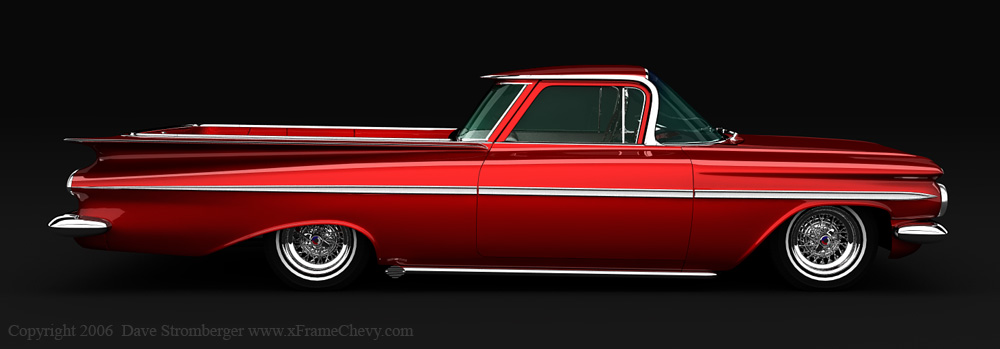 Simplicity for functionality set in and later generations had a bit more rough touch, less garnish and more mustache.
Simplicity for functionality set in and later generations had a bit more rough touch, less garnish and more mustache.
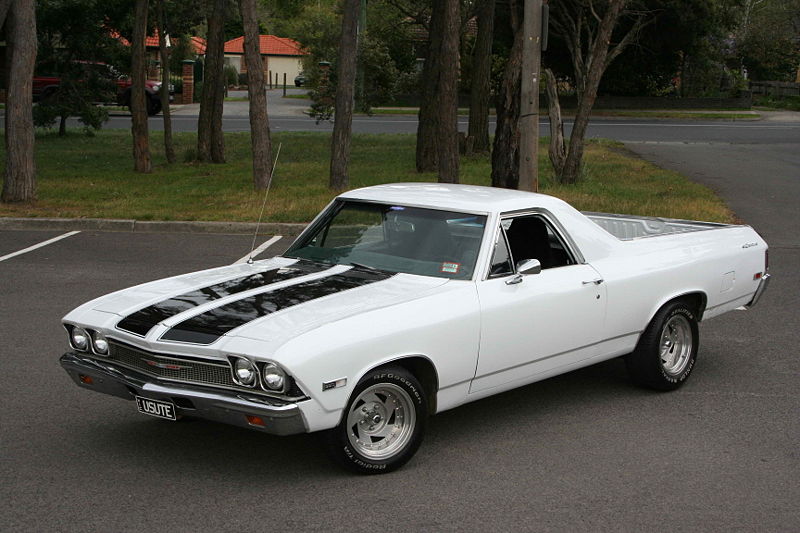 Just like Johnny Unitas sundial of a haircut, you could also calibrate your watch to predict ford playing in the ute game as well. With their stateside Ranchero pickups and their Aussie bred Flacon ute's. Australia, is a place to keep your eye out for unibody trucks.
Just like Johnny Unitas sundial of a haircut, you could also calibrate your watch to predict ford playing in the ute game as well. With their stateside Ranchero pickups and their Aussie bred Flacon ute's. Australia, is a place to keep your eye out for unibody trucks.
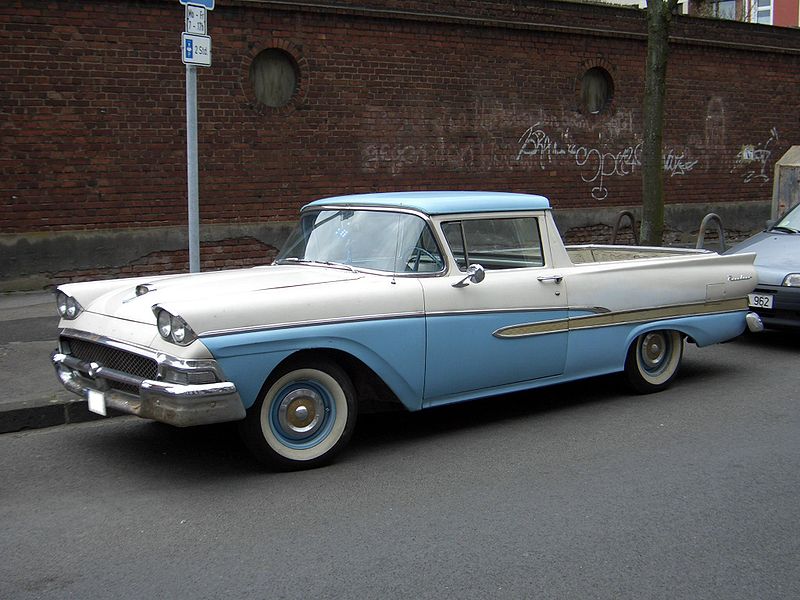
 There are a bunch more American Ute's to show, but let's skip on. A good thing to note now, is the shape of the 'B' pillar. Those in the know, know that the B pillar is the post holding the roof up at the back of the cab. The 'A' pillar is the front post holding the roof up and the windshield. 'B' Pillar shape is crucial to a good ute conversion.
Toyota played in the game as well, with the Toyota Crown pickup. The Crown ute came in multiple generations and have a early Ford Falcon ute feel to it.
There are a bunch more American Ute's to show, but let's skip on. A good thing to note now, is the shape of the 'B' pillar. Those in the know, know that the B pillar is the post holding the roof up at the back of the cab. The 'A' pillar is the front post holding the roof up and the windshield. 'B' Pillar shape is crucial to a good ute conversion.
Toyota played in the game as well, with the Toyota Crown pickup. The Crown ute came in multiple generations and have a early Ford Falcon ute feel to it.
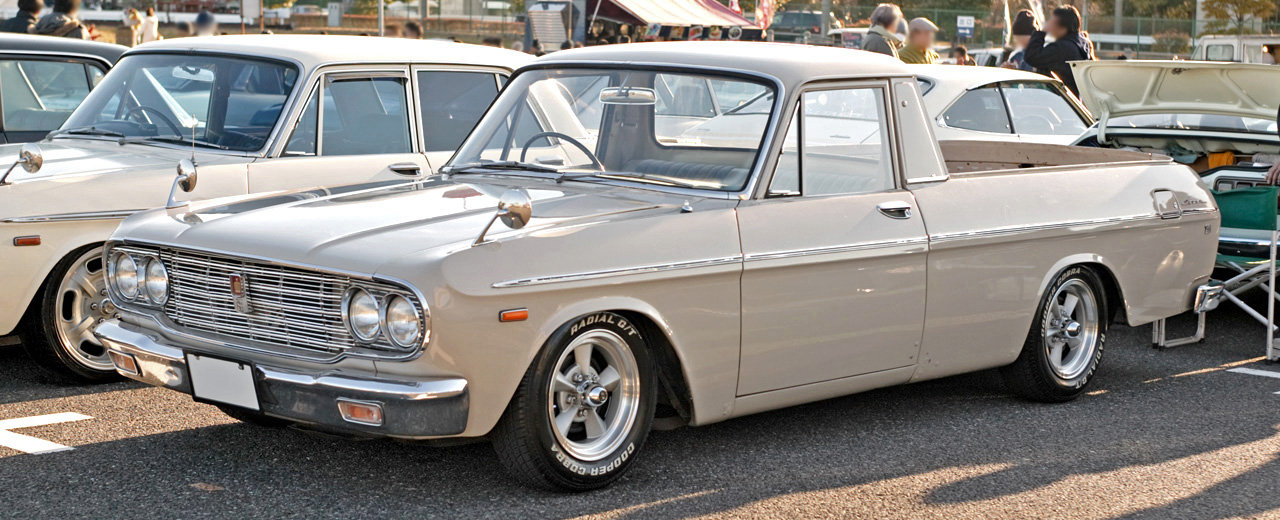 Similarly, Toyota also sold a version of their small Publica car as a utility. This ute was small, and really the beginnings of the modern, lightweight appeal of a caminoized car.
Similarly, Toyota also sold a version of their small Publica car as a utility. This ute was small, and really the beginnings of the modern, lightweight appeal of a caminoized car.
 A second Generation of the Publica brought in a very familiar shape, however....
A second Generation of the Publica brought in a very familiar shape, however....
 The ever so perfect Datsun Sunny Pickup is the epitome of cool ute's. As some would consider it the greatest of small, smooth pickups, the Sunny truck was sold in both short and long bed versions in all sorts of countries around the world and was in production in Japan until 1994, and even more recently in Africa.
The ever so perfect Datsun Sunny Pickup is the epitome of cool ute's. As some would consider it the greatest of small, smooth pickups, the Sunny truck was sold in both short and long bed versions in all sorts of countries around the world and was in production in Japan until 1994, and even more recently in Africa.
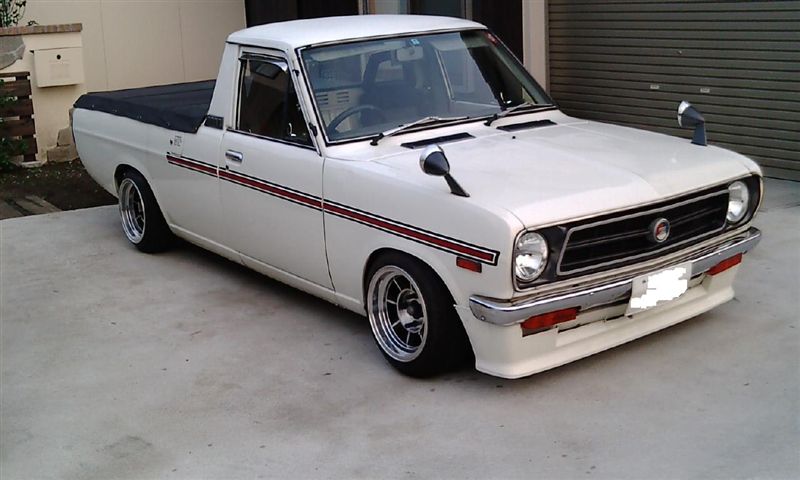 Other notable mentions come from all parts of the globe:
Hyundai Pony Pickup:
Other notable mentions come from all parts of the globe:
Hyundai Pony Pickup:
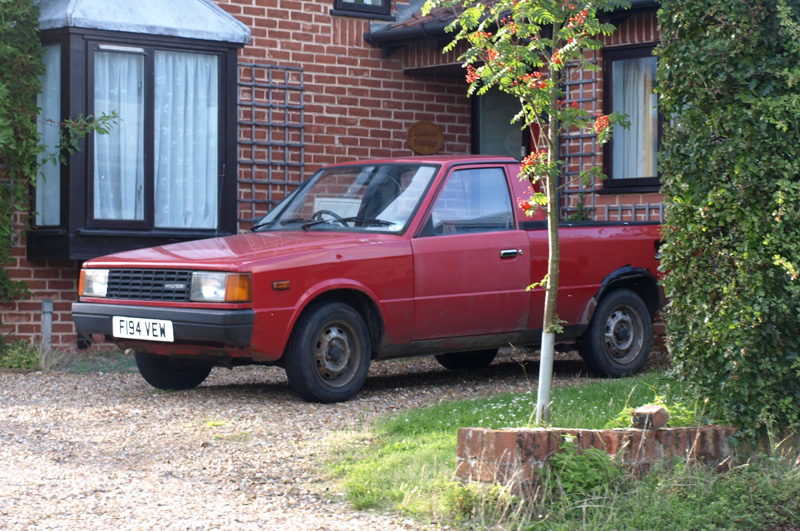 VW Saveiro:
VW Saveiro:
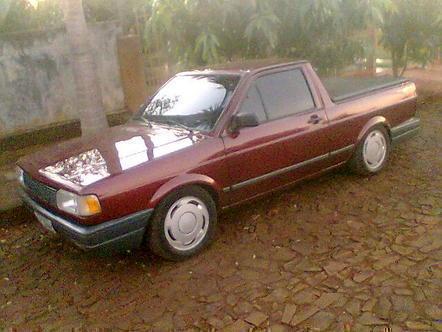 Chevy 500:
Chevy 500:
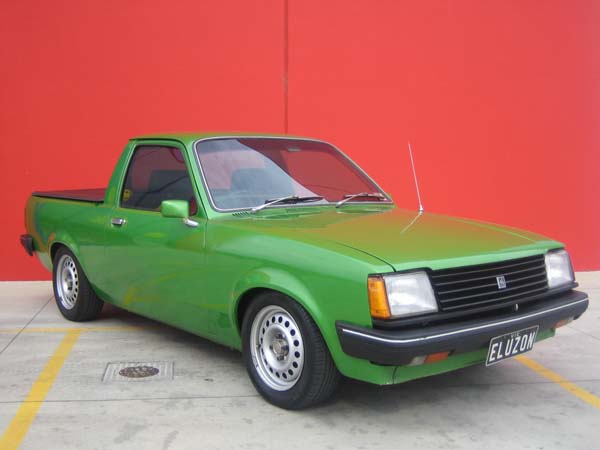 VW Caddy/Rabbit Pickup:
VW Caddy/Rabbit Pickup:
 Subaru Brat:
Subaru Brat:
 Dodge Rampage:
Dodge Rampage:
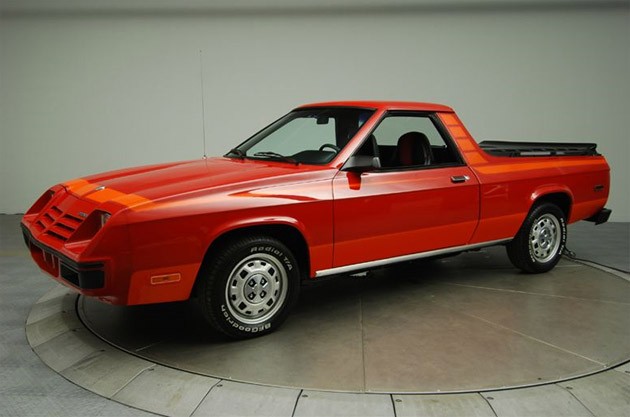 As well as many others. There's a whole slew of car....trucks not mentioned here. So what's the point then? Where's the study here? The idea begins from the usefulness of a small pickup. To be honest, the ute died along time ago. The original goal of the these car platformed trucks was to provide a utility vehicle that was cheap to operate. Light duty work was the aim, for those who need the convenience of both a car and a truck. No one still offers such a vehicle in north america, and to be honest it's the biggest gold mine waiting to happen. If you happen across an owner of a running diesel Rabbit pickup, just by chance, ask them how much they want for it. There seems to be an impossible value to a vehicle that can haul a desk at 60 mpg.
What are the crucial factors of the conversion? Simply put the B pillar shape (A), the bed/nose ratio (B) and the bed height(C). These factors are additional beyond the good styling cues of a regular vehicle. We'll cover these a little further below.
[caption id="attachment_7111" align="aligncenter" width="600" caption="A: Pillar shape, size and design. B: Bed length in-proportion to the cab and nose. C: Bed Height and slope considerations."]
As well as many others. There's a whole slew of car....trucks not mentioned here. So what's the point then? Where's the study here? The idea begins from the usefulness of a small pickup. To be honest, the ute died along time ago. The original goal of the these car platformed trucks was to provide a utility vehicle that was cheap to operate. Light duty work was the aim, for those who need the convenience of both a car and a truck. No one still offers such a vehicle in north america, and to be honest it's the biggest gold mine waiting to happen. If you happen across an owner of a running diesel Rabbit pickup, just by chance, ask them how much they want for it. There seems to be an impossible value to a vehicle that can haul a desk at 60 mpg.
What are the crucial factors of the conversion? Simply put the B pillar shape (A), the bed/nose ratio (B) and the bed height(C). These factors are additional beyond the good styling cues of a regular vehicle. We'll cover these a little further below.
[caption id="attachment_7111" align="aligncenter" width="600" caption="A: Pillar shape, size and design. B: Bed length in-proportion to the cab and nose. C: Bed Height and slope considerations."] [/caption]
Where's the best starting point? Well, to be honest, a 2 door sedan works best. Though 4 door sedans and wagons will work. The amount of work you want to do is really the determining factor and each car is different. Things to look for is a forward slanting B pillar, using the photo above as an example you can see the B pillar shape of the door as you follow it up from the waist line to the roof is backwards slanting. This is the cause of the awkward B pillar window behind it. The opposite of this is ideal and to be honest, it's difficult to find. You'll notice a majority of vehicles have a rear slanting B pillar which is often hard to work with when crafting the new B pillar. Generally the older the vehicle is, the more straight up and down the B pillar is which isn't a bad thing when doing a conversion, it just lends it self to a square approach to the new B pillar shape. Similar to that of the rabbit and sunny pickups as well as a many others. Some vehicles like a Corolla GT-S, WRX coupe and others have forwards slanting B pillars that lend themselves well to truck conversions.
[caption id="attachment_7112" align="aligncenter" width="600" caption="The WRX coupes B pillar is ideal for truck conversions, but its rear window and trunk deck height add complication."]
[/caption]
Where's the best starting point? Well, to be honest, a 2 door sedan works best. Though 4 door sedans and wagons will work. The amount of work you want to do is really the determining factor and each car is different. Things to look for is a forward slanting B pillar, using the photo above as an example you can see the B pillar shape of the door as you follow it up from the waist line to the roof is backwards slanting. This is the cause of the awkward B pillar window behind it. The opposite of this is ideal and to be honest, it's difficult to find. You'll notice a majority of vehicles have a rear slanting B pillar which is often hard to work with when crafting the new B pillar. Generally the older the vehicle is, the more straight up and down the B pillar is which isn't a bad thing when doing a conversion, it just lends it self to a square approach to the new B pillar shape. Similar to that of the rabbit and sunny pickups as well as a many others. Some vehicles like a Corolla GT-S, WRX coupe and others have forwards slanting B pillars that lend themselves well to truck conversions.
[caption id="attachment_7112" align="aligncenter" width="600" caption="The WRX coupes B pillar is ideal for truck conversions, but its rear window and trunk deck height add complication."]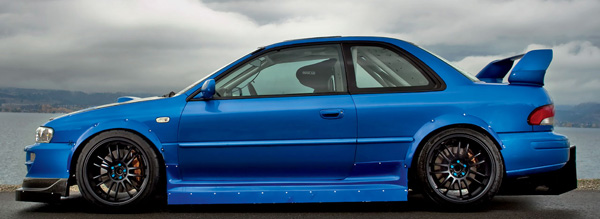 [/caption]
[/caption]
C: Bed Height and Considerations
Let's begin with C, the bed height, this is the most simple of the 3 basic design elements. Generally the bed height is level or higher with that of the waist line of the car. The waist line is that of the window ans hood. Newer cars, you'll find are difficult to truck well, not only do most of them hard rewards slanting B pillars, but their waist lines are very tall. This results in a van without a roof feel rather than that of an easy to access rear bed. Again, it can be done with careful consideration. It basically a golden rule that the height of the bed is level to, or higher than the normal waist line of the car. This is an important consideration of a truck conversions and can make or break your choice of vehicles. Again the level of effort in crafting is an important factor. If you look at the Subaru above, you'll notice that the trunk height and window edge are not level, this means, most likely one will need to build the bed height up to make the trunk height. Often in factory designed utes, the bed height is a decreasing slope. Sitting much higher than the waist line just behind the B pillar, the height of the bed drops to meet the waist line height at the back of the bed. The Ford Ranchero, El Camino, and most other factory V8 utes feature this body line. It's has a very muscle car appeal to it. Never does the bed height increase while moving towards the rear of the car, this is also a golden rule. There are rare cases of the bed height being lower than that of the waist height. This can be a tricky subject, as it gives the vehicle a 'flat bed' look, but like all 'flat bed' or as the Aussies called them 'tray' look generally the tray must extend wider than the natural width of the original body. Only in these cases of increased tray width does the lower than waist line bed height look appropriate. [caption id="attachment_7113" align="aligncenter" width="565" caption="This ford conversion is a coach built van. Note the wider rear stance to compensate for the lowered rear waistline."]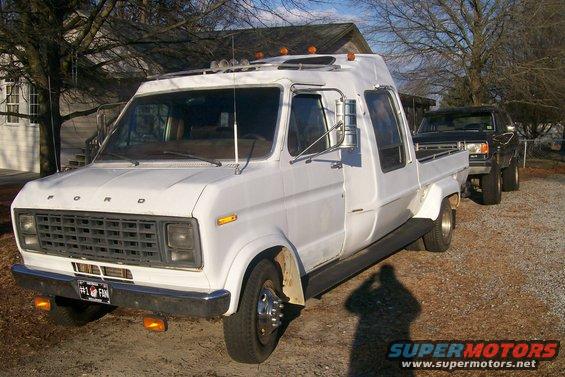 [/caption]
[caption id="attachment_7114" align="aligncenter" width="600" caption="The Chevy 500, a Chevette based Ute, sold in South America displays its properly styled raised waistline bed."]
[/caption]
[caption id="attachment_7114" align="aligncenter" width="600" caption="The Chevy 500, a Chevette based Ute, sold in South America displays its properly styled raised waistline bed."]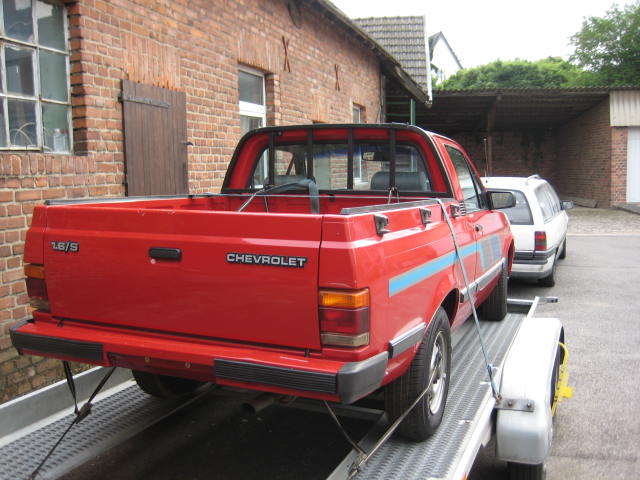 [/caption]
Bed Height Summary:
-Ideally level to, or higher than the waist line of the vehicle.
-Can slope down towards the rear of the car, but never up.
-If lower than the waist line, a widebody is strongly suggested. But generally avoid this all together.
[/caption]
Bed Height Summary:
-Ideally level to, or higher than the waist line of the vehicle.
-Can slope down towards the rear of the car, but never up.
-If lower than the waist line, a widebody is strongly suggested. But generally avoid this all together.
B: Approaching the right bed length.
As we mentioned earlier, the AE86 Corolla GT-S/SR5 (hatchback) has an ideal natural B pillar shape for a truck conversion, but why isn't it a good candidate? The next consideration for a truck conversion comes in the length of the newly designed bed. Bed length is determined by a few simple observations. The length of the body from the B pillar to the rear of the car, but a little less obvious to most is the location of the front seats and the size of the driver. These two factors determine how big the bed will really be, and how much crafting is needed to extend the B pillar shape. In many 2 door cars, a tall drivers shoulders will be even with or in some cases, behind the B original B pillar. This means, as cool as the original shape is, it will need to be extended to allow the driver some freedom in size and comfortable positioning. Stock seats are very intrusive in size and it is recommended that a fixed bucket be installed.
[caption id="attachment_7115" align="aligncenter" width="600" caption="The AE86, though a nice B pillar shape, the driver position in some cases can lead to a disproportionate short bed and an oddly far forward rear wheel arch."]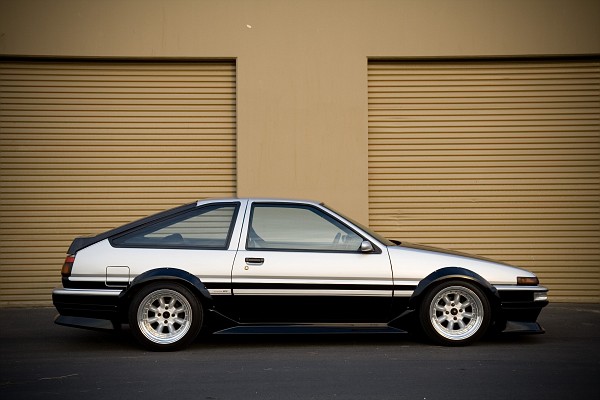 [/caption]
[/caption]
In the case of the AE86 specifically, taller drivers sit parallel with the B pillar of the car, when crafting the new B pillar, the rear wall of the Cab will be pushed back, building a new, much thicker pillar than original. This is fine, and we'll cover the design of the B pillar in section "A". However, because the cab wall moves rewards the bed becomes very short. This can case an awkward look to the final proportions of the vehicle. In some cases, the bed needs to be lengthened which is a large job. This consideration of driver placement is especially true with 4 door conversions, as the B pillar is generally even further forwards.
What's good in a bed length? Generally you can get away with a lot of variation. There are plenty of vehicles with shorter, even and longer bed lengths. The biggest issue when looking at the car is the location of the rear wheel. Locating it in the center of the bed looks best, further back or forward often looks off and strange. In the case of the Ford Durango, that's right, Durango, the overall execution and inclusion of a a rare moving tailgate was great, but the rear wheel location was just incorrect.
[caption id="attachment_7116" align="aligncenter" width="600" caption="the otherwise beautiful Durango, had a oddly located rear wheel placement. Other foxbody conversions, like the mustang suffer from the same ailment."] [/caption]
[caption id="attachment_7117" align="aligncenter" width="600" caption="The surprisingly well proportioned Datsun Sunny Pickup has a perfect rear wheel location."]
[/caption]
[caption id="attachment_7117" align="aligncenter" width="600" caption="The surprisingly well proportioned Datsun Sunny Pickup has a perfect rear wheel location."] [/caption]
[/caption]
Bed Length Summary:
- Nearly the same length of the cab and nose combined, but open for interpretation
- Rear wheel placement is crucial to a proportioned look
- Driver position can have a strong affect on the design of the bed length.
A: B Pillar Design.
So here was are, near the end of our article, but we've come to the most important piece of information. The shape and design of the B pillar makes or breaks a convincing and appealing truck conversion. Like mentioned earlier, the natural B pillar shape is helpful to creating a nice truck conversion, but isn't something that should stop you from trying. Generally a forward slanting B pillar is best to work with and creates the most convincing final look. However, if your bed proportioning and height is decent there is a large amount of room for B pillar creativity.
The most important point of a truck, whether it's a conversion, factory ute, or just a plan regular truck, is that the B pillar is the strongest pillar in the whole design. This is both important in visual and physical strength. The impact of the B pillar is always larger than that of the A pillar. It provides a strong back bone, again both physically and visually. This strength visually gives the vehicle a rigid motion appeal to it. Thin B pillars often make the vehicle look, cheap, shoddy and a very weak appearance.
[caption id="attachment_7118" align="aligncenter" width="600" caption="A fairly recent creation, this BMW has a very poor hacked feel to it. Little consideration was given to the strength and appeal of the B pillar."] [/caption]
[caption id="attachment_7119" align="aligncenter" width="600" caption="Although the working tailgate is a nice touch, I cant get past how terrible the rear of the cab is. For how curvy and expensive the rest of the car looks, the cab rear, looks cheap, the targa doesnt help."]
[/caption]
[caption id="attachment_7119" align="aligncenter" width="600" caption="Although the working tailgate is a nice touch, I cant get past how terrible the rear of the cab is. For how curvy and expensive the rest of the car looks, the cab rear, looks cheap, the targa doesnt help."]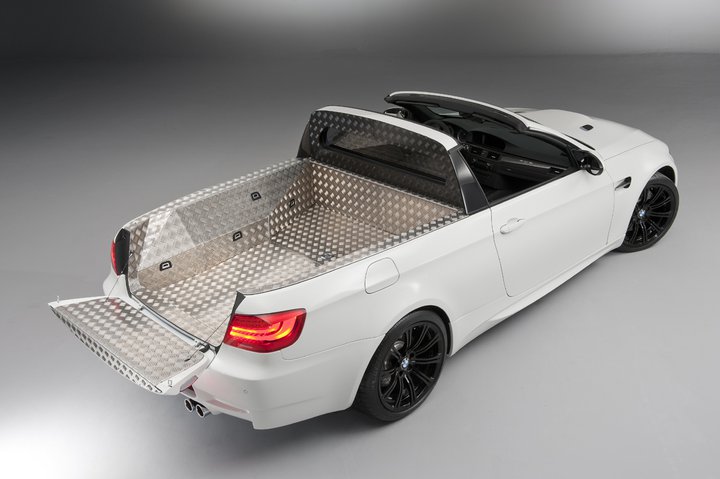 [/caption]
So what else is there to the B pillar? It's a complex subject, the angle of the B pillar should never angle back, it should always have a forward lean or curve to it. It doesn't have to be dramatic, but with a good thickness/length and a slight forwards curve or lean, the proportion of the B pillar becomes correct. See a proper example Below.
[caption id="attachment_7120" align="aligncenter" width="600" caption="Although over crafted, this M5 ute follows all of the golden rules to a T, making an extremely well considered truck conversion. The level of forethought makes the conversion more so than the quality of the finish."]
[/caption]
So what else is there to the B pillar? It's a complex subject, the angle of the B pillar should never angle back, it should always have a forward lean or curve to it. It doesn't have to be dramatic, but with a good thickness/length and a slight forwards curve or lean, the proportion of the B pillar becomes correct. See a proper example Below.
[caption id="attachment_7120" align="aligncenter" width="600" caption="Although over crafted, this M5 ute follows all of the golden rules to a T, making an extremely well considered truck conversion. The level of forethought makes the conversion more so than the quality of the finish."] [/caption]
[/caption]
So what's left to consider? The rear wall of the cab is a biggy. Small windows do not lend well to a nice looking cab backing. Generally a good rear window works with the waist line of the rest of the cab and often the best are sunken a bit into the cab. Although the B pillar may lean forwards, generally a good cab back is flat, leading to sunken rear windows.
B pillar Summary:
-A forward lean or curve is paramount. There are no good examples of reward leaning B pillars I've seen.
-The B pillar should visually be the main pillar of the roof, and provide a feeling of strength.
-The cab window looks best vertical and sunken slightly into the cab.
Below is a gallery of random truck conversion images. These are a recent selection of images I've collected, though I'm missing hundreds of megabytes of images from past computers. Some of these are factory, some conversions, some good some bad. Many of them have good parts but terrible overall shapes, with these rules posted above find the ones you like and dislike. Thanks for reading.
[gallery columns="2" orderby="ID"]
no love for the subaru baja ?
or the moke ute?! I like that merc yota conversion a lot.
Just a few pictures? hahahhaha truck lova